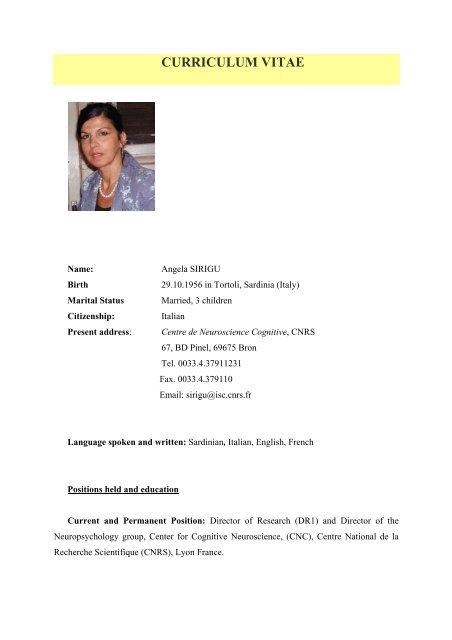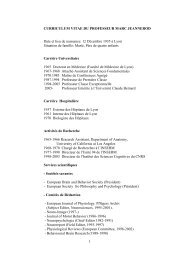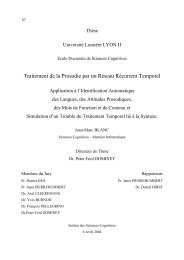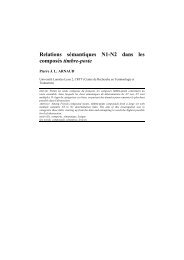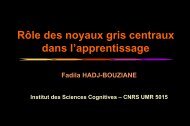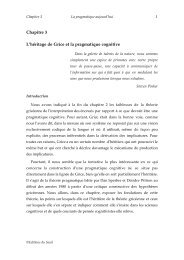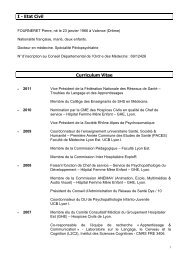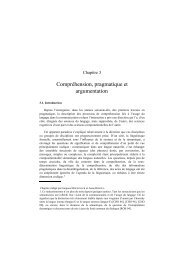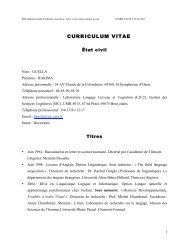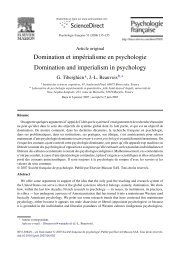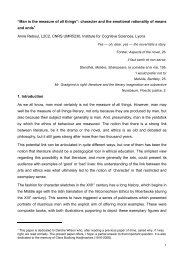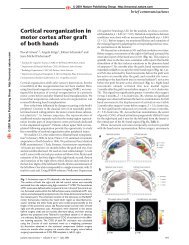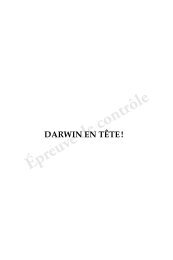curriculum vitae - CNC - Centre de Neurosciences Cognitives - CNRS
curriculum vitae - CNC - Centre de Neurosciences Cognitives - CNRS
curriculum vitae - CNC - Centre de Neurosciences Cognitives - CNRS
- No tags were found...
Create successful ePaper yourself
Turn your PDF publications into a flip-book with our unique Google optimized e-Paper software.
CURRICULUM VITAE<br />
Name:<br />
Birth<br />
Marital Status<br />
Citizenship:<br />
Present address:<br />
Angela SIRIGU<br />
29.10.1956 in Tortoli, Sardinia (Italy)<br />
Married, 3 children<br />
Italian<br />
<strong>Centre</strong> <strong>de</strong> Neuroscience Cognitive, <strong>CNRS</strong><br />
67, BD Pinel, 69675 Bron<br />
Tel. 0033.4.37911231<br />
Fax. 0033.4.379110<br />
Email: sirigu@isc.cnrs.fr<br />
Language spoken and written: Sardinian, Italian, English, French<br />
Positions held and education<br />
Current and Permanent Position: Director of Research (DR1) and Director of the<br />
Neuropsychology group, Center for Cognitive Neuroscience, (<strong>CNC</strong>), <strong>Centre</strong> National <strong>de</strong> la<br />
Recherche Scientifique (<strong>CNRS</strong>), Lyon France.
2008-2009 Invited Professor at the University of Torino.<br />
1996- Research scientist at (1class) <strong>CNRS</strong>, French Fe<strong>de</strong>ral Research Institution.<br />
1996: “Habilitation à diriger les Recherches” (<strong>de</strong>gree necessary in or<strong>de</strong>r to supervise<br />
graduate stu<strong>de</strong>nts in France), University Pierre et Marie Curie, Paris, France.<br />
1992- 96 : Invited Scientist, Laboratoire <strong>de</strong> Mé<strong>de</strong>cine Expérimentale, INSERM U 289, la<br />
Salpetriere Hospital, Paris, France.<br />
1988-1991 : "Visiting Fellow", Cognitive Neuroscience Section, National Institute of<br />
Neurological diseases and Stroke, National Institutes of Health, Bethesda, USA.<br />
1984-1987 : Post-doctoral training in Neuropsychology, Department of Neuropsychology,<br />
C.H.U. la Timone, Marseille, France.<br />
1978-1983 : PhD in Psychology, University of Rome "La Sapienza", Rome, Italy.<br />
Scholarships<br />
1988-1991 : "Fogarty Fellow", National Institutes of Health<br />
1992-1994 : "Poste Vert", INSERM, Paris, France.<br />
1994-1996 : Fellowship "Capital Humain et Mobilité" European Community (C.E.E.)<br />
Awards<br />
1999- Award of the French Aca<strong>de</strong>my of Science.<br />
Doctoral and post-graduate teaching<br />
1986-87 : DEA of Cognitive Neuropsychology (University of Marseille).<br />
1989-90 : Cognitive Neuropsychology (Department of Neurology, Naval Hospital,<br />
Bethesda, USA).<br />
1990-91: Cognitive Neuropsychology (Foundation for the Advancement of Education in<br />
Sciences, Bethesda, USA).<br />
1998-2002 : Neuropsychology, Clau<strong>de</strong> Bernard University, Lyon 1, France.<br />
2001-2002 : Course in Cognitive Neuroscience, Medical School, University of Udine,<br />
Italy.<br />
2003-2004: Course in Cognitive Neuroscience, Clau<strong>de</strong> Bernard University, Lyon 1&2,<br />
France.<br />
2005-2007 Course in Cognitive Neuroscience, University of Trieste, Italy
2008-2009 Co-organiser with JR Duhamel of a course in Cognitive Neuroscience at the<br />
Ecole Normale Superieure, Lyon, France.<br />
Doctoral supervision (PhD)<br />
1999-2005 : Pascal Giraux, 09-2003; Gilles Lafargue, 11-2003; Nathalie Camille,<br />
09/2004; Mateus Joffily, 27-01-2005, David Auclair, June 2005; Céline Fragne, October<br />
2005.<br />
2006 to present: Antoine Aballea, Elissar Andari, Irene Cristofori, Helene Parmentier<br />
Master<br />
since 1995: I supervised 40 stu<strong>de</strong>nts.<br />
Membership<br />
Since 1999 : Member of the Scientific Comity of the Doctoral program in Cognitive<br />
Science, University Lyon 2, Lyon, France.<br />
Since 1999: Member of the Scientific Committee of the Doctoral program in<br />
Neuroscience, University, Clau<strong>de</strong> Bernard University (UCLB), Lyon 1, France.<br />
Since 1995: Member of the New York Aca<strong>de</strong>my of Science.<br />
Since 1995: Member of the Scientific Council of Attention & Performance Society<br />
Since 2000 : Member of the International Neuropsychological Symposium (INS).<br />
Since 2005: Member of the Scientific Committee ‘ATIPE’, <strong>CNRS</strong>.<br />
Since 2006: Member of Scientific Section 27, Comité National du <strong>CNRS</strong> (This is the<br />
<strong>CNRS</strong> Scientific Committee in charge of (1) recruiting scientists for permanent positions and<br />
fro (2)Labs reviews and their renewal.<br />
Since 2007: Member of the Scientific Committee “Fondation pour la Recherche<br />
Médicale”.<br />
Reviewer for:<br />
• Journals: Behavioural Brain Research, Brain, Brain Research, Cognition, Cognitive<br />
Neuropsychology, Cortex, Cerebral Cortex, Current Biology, Experimental Brain<br />
Research, European Journal of Neuroscience, Journal of Experimental<br />
Psychology :Human Perception and Performance, Journal of Neuroscience, Journal of<br />
Neurology, Neurosurgery and Neuropsychyatry, Journal of Neuroscience,<br />
Neuropsychologia, Neuroreport, Nature Neuroscience , Quaterly Journal of Experimental<br />
Psychology, PNAS, Progress in Neurobiology, Revue Neurologique, Science, Trends in<br />
Cognitive Science.
• Public and private Institution: ANR, Pierre et Marie Curie University, Cariverona<br />
Foundation, Fyssen, Fondation pour la Recherche Médicale.<br />
Grants (Principal Investigator in all)<br />
1996-1999: GIS- Sciences <strong>de</strong> la Cognition, (120.000Euros).<br />
1999-2001 : Cognitique, Ministry of French Research (40.000Euros)<br />
2000-2002 : Emergence, Rhône-Alpes Department, (60.000).<br />
2000-2003 : Ministry of Health (PHRC) (150.000Euros)<br />
2000-2004 : -ACI, Ministry of Research (30.000Euros)<br />
2003-2004: France Parkinson, (20.000Euros)<br />
2002-2005 : National Science Foundation with Marc Schieber (University of Rochester,<br />
USA (940.000$) Co-PI.<br />
2005-2008; Human Frontier Program with Colin Camerer, Caltech Pasa<strong>de</strong>na; JR<br />
Duhamel, <strong>CNRS</strong> Lyon; Rosemarie Nagel University of Pompeu Fabra, Spain<br />
($1.350,000)<br />
2005-2008 European Science Foundation (ESF) (70.000€)<br />
2006-2009 ANR (300.000€)<br />
2007-2009 Fondation <strong>de</strong> France (85,000€)<br />
2008-2011 : ANR (400,000€ approved)<br />
Large Network Grants<br />
2007-20012 RTRA on Composite Tissue and Transplantation, Lyon (Co-PI)<br />
2007-20012 RTRA on Neuroscience, Lyon, (Co-PI)<br />
Selected media coverage about my research:<br />
Newspapers: Le Mon<strong>de</strong> (January 2004,), l’Humanité, Le Figaro, L’Expansion, New York<br />
Times, Herald Tribune, La Reppublica, Il Corriere <strong>de</strong>lla Sera, Ansa agency.<br />
Magazines: « A life of Regret » Nature Highlight, 436, 11, 2005.<br />
“Le rôle du regret dans la prise <strong>de</strong> décision “. LE MONDE, 21.05.04, by Hervé Morin..<br />
“Nella testa di chi non conosce il rimpianto“. IL CORRIERE DELLA SERA, by Massimo<br />
Piattelli Palmarini 21.05.04.
“Vital signs: emotions; Winning, Losing and Regretting“. THE NEW YORK TIME. by<br />
John O'Neil, May 25, 2004.<br />
“Brain Region Tied to Regret I<strong>de</strong>ntified”. SCIENTIFIC AMERICAN. by Sarah Graham,<br />
8 August 2005.<br />
“Where Regret Roosts in the Brain”. FOX NEWS. By Miranda Hitti, August 08, 2005.<br />
“Pinpointing regret in the brain”. NEW SCIENTIST. 13 August 2005 by Rowan Hooper.<br />
TV and Radio: France Info, France 3, France 2, TLM, BBC World News, Radio24, RAI-<br />
Radio3.<br />
International collaborations<br />
Jordan Grafman, Congitive Neuroscience Unit, NINDS, NINH, Bethesda, USA<br />
Elena Daprati, Francesco Lacquaniti (Université <strong>de</strong> Rome).<br />
Patrick Haggard (ICN, University College, Londres, UK),<br />
Sarah Blakemore, (ICN, University College, Londres, UK).<br />
James Kilner, (Fil, University College, Londres, UK).<br />
Ray Dolan, (Fil, Londres, UK).<br />
Marc Schieber (Université <strong>de</strong> Rochester, USA)<br />
Colin Camerer (Calthech, Pasa<strong>de</strong>na, USA)
PUBLICATIONS<br />
Ten selected publications since my career<br />
Sirigu, A., Duhamel, J.R., Cohen, L., Pillon, B., Dubois, B., Agid, Y. (1996) The mental<br />
representation of hand movements after parietal cortex damage. Science, 273, 1564-1568.<br />
Giraux P., Sirigu A., Schein<strong>de</strong>r F. , Dubernard, JM (2001) Cortical reorganization in<br />
motor cortex after graft of both hands. Nature Neuroscience, 4, 691-692.<br />
Farné A, Roy A, Giraux P, Dubernard JM, Sirigu A. (2002) Face or hand but not both:<br />
perceptual correlates of reafferentation in a former amputee. Current Biology, 12, 1-5.<br />
Sirigu A. Daprati E. Ciancia S., Giraux P., Nighoghossian N., Posada A., Haggard P.<br />
(2004) Motor awareness and intention to move after focal brain damage. Nature<br />
Neuroscience, 7 80-4.<br />
Camille N., Coricelli G., Sallet J. Pradat-Diehl P., Duhamel JR, Sirigu A. (2004) The<br />
involvement of the orbitofrontal cortex in the experience of regret. Science, 21, 1167-70.<br />
Kilner J., Vargas C., Duval S., Blakemore SJ, Sirigu A. (2004) Motor activation prior a<br />
predicted observed movement. Nature Neuroscience, 7, 1299-301.<br />
Coricelli, G., Camille, N., Pradat-Diehl, P, Duhamel, JR, Sirigu, A. (2005). Why<br />
Anticipated Regret Influences Subjects’ Choice. Science, 308, 1260-1261.<br />
Coricelli G, Critchley HD, Joffily M, O'doherty JP, Sirigu A, Dolan RJ. (2005) Regret and<br />
its avoidance: a neuroimaging study of choice behavior. Nature Neuroscience, 1255-62.<br />
Daprati E., Sirigu A. (2006) How we interact with objects: learning from brain lesions.<br />
(2006) Trends in Cognitive Science, 10, 265-70.<br />
Coricelli, G., Dolan, RJ., Sirigu A. (2007) Brain, emotion and <strong>de</strong>cision-making: the<br />
paradigmatic example of regret. Trends in Cognitive Science, 11, 258-65.<br />
Complete list of publications<br />
1. Habib, M., Sirigu, A. (1987) Pure Topographical Disorientation: A <strong>de</strong>finition and<br />
anatomical basis. Cortex, 1, 73-85.<br />
2. Sirigu, A., Grafman, J., Bressler, K., Sun<strong>de</strong>rland, T. (1991) Multiple representations<br />
contribute to body knowledge processing: evi<strong>de</strong>nce from a case of autotopagnosia. Brain,<br />
114, 629-642.<br />
3. Sirigu, A., Duhamel, J-R. Poncet, M. (1991) The role of sensorimotor experience in<br />
object recognition: A case of multimodal agnosia. Brain, 114, 2555-2573.
4. Duhamel, J.-R., Goldberg, M., Sirigu, A., Fitzgibbon, E.J., Grafman,J. (1992) Saccadic<br />
dysmetria in a patient with right fronto-parietal lesion: role of corollary discharge for accurate<br />
spatial performance. Brain, 115, 1387-1402.<br />
5. Grafman, J., Litvan, I., Massaquoi, S., Stewart, M., Sirigu, A., Hallet, M. (1992)<br />
Cognitive planning <strong>de</strong>ficit in patients with cerebellar atrophy. Neurology, 42, 1493-1496.<br />
6. Grafman, J., Sirigu, A., Spector L., Hendler, J. (1993) Damage to the prefrontal cortex<br />
leads to <strong>de</strong>composition of structured events complex. Journal of Head Trauma<br />
Rehabilitation. 8,73-87.<br />
7.Sirigu, A., Cohen, L., Duhamel, J.R., Pillon, B., Dubois, B., Agid, Y., Pierrot-<br />
Deseilligny C. (1995). Congruent unilateral impairments for real and imagined hand<br />
movements. NeuroReport, 6, 997-1001.<br />
8. Sirigu, A., Cohen, L., Duhamel, J.R., Pillon, B., Dubois, B., Agid, Y. (1995) A<br />
selective impairment of hand posture for object utilization in apraxia. Cortex, 31, 41-56.<br />
9. Litvan,I., Sirigu, A., Toothman, J., Grafman, J. (1995) What can preservation of<br />
autobiographical memory after muscarine blocka<strong>de</strong> tell us about the scopolamine mo<strong>de</strong>l of<br />
<strong>de</strong>mentia Neurology , 45, 387-389.<br />
10.Sirigu, A., Zalla, T., Pillon, B., Dubois, B., Grafman, J., Agid, Y. (1995) Selective<br />
impairments in managerial knowledge in patients with pre-frontal cortex lesions. Cortex , 31,<br />
301-316.<br />
11.Sirigu, A., Zalla, T., Pillon, B., Dubois, B., Grafman, J., Agid, Y. (1995) Planning<br />
process after frontal lobe lesions. Annals of New York Aca<strong>de</strong>my of Science , 769, 277-288.<br />
12.Sirigu, A., Grafman, J. (1996) Selective impairments within episodic memories.<br />
Cortex, 32, 83-95.<br />
13. Sirigu, A., Zalla, T., Pillon, B., Dubois, B., Grafman, J., Agid, Y. (1996) Encoding of<br />
sequence and boundaries of script following prefrontal lesions. Cortex , 32, 297-310.<br />
14. Pillon, B., Blin, J., Vihailhet, M., Deweer, B., Sirigu, A., Dubois, B., Agid, Y. (1995)<br />
The neuropsychological pattern of cortico-basal <strong>de</strong>generation. Neurology, 45,1477-1483.<br />
15. Sirigu, A., Duhamel, J.R., Cohen, L., Pillon, B., Dubois, B., Agid, Y. (1996) The<br />
mental representation of hand movements after parietal cortex damage. Science, 273, 1564-<br />
1568.<br />
16. Loarer, E. Lautrey, J., Pillon, B., Sirigu, A. (1996). Validation of a planning task in<br />
normals and patients with prefrontal cortical lesions. European Review of Applied<br />
Psychology, 48, 41-47.<br />
17. Cohen, L., Brazin, B., Sirigu, A., Meininger, V., Pierrot-Desseilligny, C. (1997)<br />
Progressive upper limb monoparesis: a form of primary lateral sclerosy Two cases with
metabolic brain imaging an transcranial magnetic stimulation. European Journal of<br />
Neurology, 4, 294-296.<br />
18. Sirigu, A., Cohen, L., Zalla, T., Pradat-Diehl, P., Van Eeckhout, P., Grafman, J., Agid,<br />
Y. (1998). Distinct frontal regions for processing sentence syntax and story grammar. Cortex,<br />
34, 771-778.<br />
19. Zalla, T., Sirigu, A., Pillon, B., Dubois, B., Agid, Y., Grafman, J., (1998). Deficit in<br />
script sequence evaluation in Parkinson’s disease. Cortex, 34, 621-628.<br />
20. Zalla, T., Sirigu, A., Pillon, B., Dubois, B., Agid, Y., Grafman, J., (1998). Deficit in<br />
script sequence evaluation in Parkinson’s disease. Cortex, 34, 621-628.<br />
21. Babin-Ratté, S., Sirigu, A. Gilles, M, Wing, A. (1999). Impaired anticipatory finger<br />
grip force adjustments in a case of cerebellar <strong>de</strong>generation. Exp. Brain Research, 128, 81-85.<br />
22. Sirigu, A., Daprati, E., Pradat-Diehl, P, Frank, N., Jeannerod, M. (1999). Perception of<br />
self-generated movement following left parietal lesion. Brain, 122, 1867-1874.<br />
23. Crozier S., Sirigu, A., Lehéricy S., Van <strong>de</strong> Moortele P.F, Guigon E., Pillon B., Dubois<br />
B., Grafman J., LeBihan, D., Agid Y. Distinct prefrontal activations in processing sequence of<br />
actions and words: A fMRI study at 3Tesla. (1999) Neuropsychologia, 37, 1469-1476 .<br />
24. Zalla, T., Sirigu, A., Pillon, B., Dubois, B., Agid, Y., Grafman, J., (2000). How<br />
patients with Parkinson’s disease retrieve and manage action knowledge. Cortex, 36, 163-179.<br />
25. Zalla, T., Koechlin, E., Pietrini, P., Basso, G., Aquino, P., Sirigu, A., Grafman, G.<br />
(2000) Differential amygdala responses to winning and losing in humans. European Journal<br />
of Neuroscience 12, 1764-1770.<br />
26. Baron S., Gorce P., Didi N., Pradat-Dihel P., Sirigu A. (2000) Biomechanical analysis<br />
of prehension movement. European Journal of Automation, 34, 835-844<br />
27. Gerardin E., Sirigu, A., Lehéricy S., Poline JB, Gaymard, B., LeBihan D., Agid Y.<br />
(2000) Partially overlapping neural network for imagined and executed movement. Cerebral<br />
Cortex, 10, 1093-104.<br />
28. Daprati, E., Sirigu, A., Pradat-Diehl, P, Frank, N., Jeannerod, M. (2000) Recognising<br />
the self: Denial of ownership of the contralesional hand in a case of severe neglect.<br />
Neurocase, 6, 477-486.<br />
29. Sirigu, A., Duhamel, J.R. Rôle du cortex pariétal dans la représentation <strong>de</strong>s<br />
mouvements manuels. Revue Psychologie Française, 45-4.<br />
30. Cazalis, F., Azouvi, P., Sirigu, A., Agar., N., Burnod, Y. (2001) Script generation and<br />
reconstitution after severe traumatic brain injury. Journal of the International<br />
Neuropsychological Society, 7, 795-804.
31. Zalla, T., Plassiart, C., Pillon, B., Grafman J., Sirigu, A. Action planning in a virtual<br />
context after prefrontal cortex damage. Neuropsychologia, 39, 759-770, 2001.<br />
32. Sirigu, A., Duhamel, J.R. (2001) Motor and visual imagery as two complementary and<br />
neurally dissociable mental processes. Journal of Cognitive Neuroscience, 13, 7, 910-919.<br />
33. Giraux P., Sirigu A., Schein<strong>de</strong>r F. , Dubernard, JM (2001) Cortical reorganization in<br />
motor cortex after graft of both hands. Nature Neuroscience, 4, 691-692.<br />
34. Zalla, T. Posada, A. Franck, N. Georgieff, N., Sirigu, A. (2001). A componential<br />
analysis of action planning in patients with schizophrenia: A comparison with patients with<br />
frontal lobe damage. Cognitive Neuropsychiatry, 6, 271-296.<br />
35. Daprati E. Sirigu E. How well do we know our non-dominant hand laterality effects<br />
on motor awareness (2002) Neuropsychologia, 40, 1379-86.<br />
36. Angela Sirigu, Elena Daprati, Laurel J. Buxbaum2, Pascal Giraux. (2002). How the<br />
Human Brain Represents Manual Gestures: Effects of Brain Damage. A paraître dans:<br />
Cognitive Neuroscience Perspectives on the Problem of Intentional Action. Scott H.<br />
Johnson (Ed.), MIT Press.<br />
37. Ruby, P., Sirigu, A. Decety, J. (2002) Long term and short term action planning with<br />
scripts: a Pet investigation. Cortex, 38, 321-39.<br />
38. Lafargue G., Sirigu, A. (2002). Sensation of effort is altered in Huntington’s disease.<br />
Neuropsychologia, 1400, 1-8.<br />
39. Farné A, Roy A, Giraux P, Dubernard JM, Sirigu A. (2002) Face or hand but not both:<br />
perceptual correlates of reafferentation in a former amputee. Current Biology, 12, 1-5.<br />
40. Sirigu, A., Camille, N., Zalla, T., Pradat-Diehl, P. Planification <strong>de</strong> l’action chez<br />
l’homme. (2002) Revue <strong>de</strong> Psychologie Française, 47, 21-30.<br />
41. Buxbaum, L., Sirigu, A., Schwartz, M., Klatzty, R. (2003). Cognitive representation of<br />
hand posture in i<strong>de</strong>omotor apraxia. Neuropsychologia, 41, 1091-113, 2003<br />
42. G. Lafargue, J. Paillard, Y. Lamarre, A. Sirigu (2003) Production and perception of grip<br />
force without proprioception: is there a sense of effort in <strong>de</strong>afferented subjects European<br />
Journal of Neuroscience, 17, 2741-9, 2003.<br />
43. T. Zalla, P. Pradat-Diehl, A. Sirigu (2003). Perception of Action Boundaries in Patients<br />
with Frontal Lobe Damage, Neuropsychologia, 41, 1619-27.<br />
44. S. Blakemore, A. Sirigu (2003) Action prediction in the cerebellum and in the parietal<br />
lobe. Experimental Brain Research, 153, 239-45.<br />
45. Elena Daprati, Daniele Nico, Nicolas Franck, Angela Sirigu (2003) Being the agent:<br />
Memory for action events. Consciousness and Cognition, 12, 670-83.
46. Giraux P. Sirigu A. (2003) Virtual movements of the paralysed hand restore motor<br />
cortex activity. Neuroimage, 20, 107-11.<br />
47. D. Nico, E. Daprati, F. Rigal, L. Parsons, A. Sirigu (2004) Hands recognition in upper<br />
limb amputees. Brain, 127, 120-32.<br />
48. Sirigu A. Daprati E. Ciancia S., Giraux P., Nighoghossian N., Posada A., Haggard P.<br />
(2004) Motor awareness and intention to move after focal brain damage. Nature<br />
Neuroscience, 7 80-4.<br />
49. T. Zalla, I. Verlut, N.Franck, D. Puzenat, A. Sirigu (2004). Perception of dynamic<br />
action in patients with schizophrenia. Psychiatry Research, 30, 39-51.<br />
50. Neppi-Modona M., Auclair D., Sirigu A., Duhamel JR (2004) Spatial coding of the<br />
predicted impact location of a looming object. Current Biology, 14, 1174-80.<br />
51. Elena Daprati, Daniele Nico, Arnaud Saimpont, Angela Sirigu. (2003). Memory for<br />
Actions: Facilitating Role of Semantic Congruence and Motor Awareness. Neuropsychologia,<br />
(in press).<br />
52. Camille N., Coricelli G., Sallet J. Pradat-Diehl P., Duhamel JR, Sirigu A. (2004) The<br />
involvement of the orbitofrontal cortex in the experience of regret. Science, 21, 1167-70.<br />
53. Vargas C.D., Olivier E., Craighero L, Fadiga L., Duhamel, J.R., Sirigu A. (2004) The<br />
influence of hand posture on corticospinal excitability during motor imagery: a transcranial<br />
magnetic stimulation study. Cerebral Cortex 14, 1200-6.<br />
54. Tsakiris M., Sirigu A., Franck N., Haggard P.(2005) A specific role for efferent<br />
information in self-recognition. Cognition. 96, 215-31.<br />
55. Sirigu A, Duhamel JR (2005) Movement, action and consciousness: toward a<br />
physiology of intentionality. A special issue in honor of Marc Jeannerod. Neuropsychologia.,<br />
43, 149-50.<br />
56. Daprati E, Nico D, Saimpont A, Franck N, Sirigu A. (2005) Memory and action: an<br />
experimental study on normal subjects and schizophrenic patients. Neuropsychologia., 43,<br />
281-93<br />
57. Kilner J., Vargas C., Duval S., Blakemore SJ, Sirigu A. (2004) Motor activation prior<br />
a predicted observed movement. Nature Neuroscience, 7, 1299-301.<br />
58. Coricelli, G., Camille, N., Pradat-Diehl, P, Duhamel, JR, Sirigu, A. (2005). Why<br />
Anticipated Regret Influences Subjects’ Choice. Science, 308, 1260-1261.<br />
59. Coricelli G, Critchley HD, Joffily M, O'doherty JP, Sirigu A, Dolan RJ. (2005) Regret and<br />
its avoidance: a neuroimaging study of choice behavior. Nature Neuroscience, 1255-62.
60. Lafargue G., Franck N., Sirigu A. (2006) Sense of motor effort in schizophrenia.<br />
Cortex;42,711-9.<br />
61. Lafargue G., Sirigu A. Nature et substratum neurologique du sense <strong>de</strong> l’effort. Revue<br />
Neurologique (2006) 162, 703-712<br />
62. Daprati E., Sirigu A. (2006) How we interact with objects: learning from brain lesions.<br />
(2006) Trends in Cognitive Science, 10, 265-70.<br />
63. Petruzzo P, Ba<strong>de</strong>t L, Gazarian A, Lanzetta M, Parmentier H, Kanitakis J, Sirigu A,<br />
Martin X, Dubernard JM. (2006) Bilateral hand transplantation: six years after the first case.<br />
American Journal of Transplantation 6, 1718-24.<br />
64. Mercier C, Reilly KT, Vargas CD, Aballea A, Sirigu A. (2006) Mapping phantom<br />
movement representations in the motor cortex of amputees. Brain, 129, 2202-10.<br />
65. Reilly KT, Mercier C, Schieber MH, Sirigu A. (2006) Persistent hand motor<br />
commands in the amputees' brain. Brain, 2211-23.<br />
66. Coricelli, G., Dolan, RJ., Sirigu A. (2007) Brain, emotion and <strong>de</strong>cision-making: the<br />
paradigmatic example of regret. Trends in Cognitive Science, 11, 258-65.<br />
67. Mercier C, Aballea A, Vargas C, Paillard J, Sirigu A. (2007) Vision without<br />
Proprioception Modulates Cortico-spinal Excitability during Hand Motor Imagery. Cerebral<br />
Cortex. May 20.<br />
68. Reilly KT, Mercier C, Schieber MH, Sirigu A., (2007) Persistent hand motor commands<br />
in the amputees' brain: a reply to Levine. Brain, 130, 65.<br />
69 Dubernard JM, Testelin S., Morelon E., Sirigu A, Petruzzo P. Martin X., Devauchelle B.<br />
(2007) First face transplantation in human: fourteen months follow up. New England Journal<br />
of Medicine (in press)<br />
70. Gazarian A, Abrahamyan DO, Petruzzo P, Kanitakis J, Sirigu A, Dubernard JM, Eljaafari.<br />
Hand allografts: experience from Lyon team. Ann Chir Plast Esthet. 52:424-435, 2007<br />
71. Reilly K. Sirigu A. The motor cortex and its role in phantom limb phenomena (2007) The<br />
Neuroscientist 14195-202.<br />
72. Lafargue G, D’Amico A., Thobois S., Broussolle E., Sirigu A. (2008) The ability to assess<br />
muscular force in asymmetrical parkinson's disease. Cortex, 44, 82-9.<br />
73. Carota F., Sirigu , A. (2008) Neural bases of sequence processing in action and language.<br />
Journal of Language and Learning (in press).
Book Chapters<br />
1. Dubois, B., Vérin, M., Teixeira-Ferreira, C., Sirigu, A., Pillon, B. (1993). How to study<br />
frontal lobe functions in humans. In Motor and cognitive functions of the prefrontal cortex.<br />
Thierry, A.M., Glowinski, J., Goldman-Rakic, P., Christen, Y. (Eds.), Springer-Verlag.<br />
2. Dubois, B., Pillon, B., Sirigu, A. (1993) Fonctions intégratices et cortex préfrontal chez<br />
l'homme. Traité <strong>de</strong> Neuropsychologie Humaine. Seron, X., Jeannerod, M. (Eds.) Bruxelles,<br />
Mardaga.<br />
3. Dubois, B., Pillon, Malapani, C., Deweer, B., Vérin, M., Partiot, A., Défontaines, B.,<br />
Sirigu, A., Teixeira, C., Agid, Y. (1993) Subcortical <strong>de</strong>mentia and Parkinson's disease: what<br />
are the cognitive functions of the basal ganglia In: Wolters, E.Ch., Scheltens, P. (Eds.) Vrije<br />
Universiteit, Amsterdam.<br />
4. Sirigu, A., Pradat-Diehl, P., Zalla, T. Rôle du cortex préfrontal dans la représentation et<br />
la planification <strong>de</strong> l’action. Dans “Syndrome Frontal: Evaluation et Rééducation”, Actes <strong>de</strong>s<br />
11 e Entretiens <strong>de</strong> l’Institut Garches, pp.49-56, 1998.<br />
5. Daprati E., Sirigu A. (2005) Action recognition disor<strong>de</strong>rs following parietal damage in<br />
Higher-Or<strong>de</strong>r Motor Disor<strong>de</strong>rs: from Neuroanatomy and Neurobiology to Clinical<br />
Neurology, (HJ Freund, M Jeannerod , M Hallett, R Leiguarda (Eds). Oxford University<br />
Press.<br />
6. P.Giraux, A.Sirigu, F. Schnei<strong>de</strong>r ,J.M.Dubernard. Cortical reorganization after hand<br />
transplantation In : Composite Tissue Allografts, (Dubernard JM Ed), John Libbey Eurotext,<br />
Paris, 2001.<br />
7. Aballéa A., Giraux P., Schieber M., Sirigu A. (2007) Human brain plasticity after bilateral<br />
hand allograft. In: Hand transplantation (Lanzetta M., Dubernard JM, Eds), Springer.<br />
8. Schieber, MH, Lang, CE, Reilly, KT, McNulty, P, Sirigu, A. Selective activation of human<br />
finger muscles after stroke or amputation (2007) In: Progress in Motor Control – a<br />
Multidisciplinary Perspective (Ed. Dagmar Sternad), New York, Springer.<br />
People Science articles<br />
Sirigu A., Camille N., Coricelli G. Les Bon raison d’avoir <strong>de</strong>s regrets. (2005) Cerveau &<br />
Psycho, 9, 37-41.<br />
Lafargue G., Sirigu A. (2004) La volonté d’agir est-elle libre Neuropsychologie <strong>de</strong><br />
l’intentionnalité. Cerveau & Psycho, 6, 2-7.<br />
Giraux P., Sirigu A. (2003). Mains perdues, mains greffées: comment le cerveau retrouve<br />
ses mains La Recherche, 366, 2-8.
Conference Abstracts (*published):<br />
1. Sirigu, A., Habib, M. Spatial self-orientation disturbance with right mesial temporal<br />
lobe lesions. (Workshop in Clinical Neuropsychology, European Brain and Behavior Society,<br />
Zurich, April 11, 1985).<br />
2. Sirigu, A., Duhamel, J.-R., Poncet, M. I<strong>de</strong>ntification <strong>de</strong>s objets dans un cas<br />
d'encéphalite herpétique: dissociation entre "comment on s'en sert" et "à quoi ça sert".<br />
(Société <strong>de</strong> Neuropsychologie <strong>de</strong> Langue française, Paris, Décembre 1985).<br />
3. Sirigu, A., Duhamel, J.-R., Poncet, M. Sensori-motor and cognitive processes in object<br />
recognition: case study of an agnosic patient with bilateral mesial temporal lobe lesions (4th<br />
European Workshop in Cognitive Neuropsychology, Bressanone, Italy, January 19-24, 1986)<br />
4*. Sirigu, A., Grafman, J., Bressler, K., Sun<strong>de</strong>rland, T. (1989) Impaired body parts<br />
localization with preserved body reference system.Society for Neuroscience Abstracts, 15,<br />
Part 1, p.728.<br />
5*. Duhamel J.-R., Fitzgibbon, E.J., Sirigu, A., Grafman, J. (1990) Saccadic eye<br />
movements following parietal cortex lesions. Society for Neuroscience Abstracts, 15, pp.899.<br />
6. Sirigu, A., Grafman, J. Fractioning Autobiographical memory. (NIH Research<br />
Workshop, September 1990, Bethesda, USA).<br />
7*. Sirigu, A., Grafman, J., Litvan, I., Toothman, J. (1991) Autobiographical memory in<br />
normals and brain-damaged subjects. Society for Neuroscience Abstracts, 17, 477.<br />
8*. Litvan, I., Grafman, J., Massaquoi, S., Stewart, M., Sirigu, A., Hallet, M. (1991)<br />
Cognitive planning <strong>de</strong>ficit in patients with cerebellar <strong>de</strong>generation. Neurology, 41(suppl.1),<br />
225.<br />
9*. Chavoix, C., Hagger, C., Sirigu, A., Gravelle, M., Aigner, T. (1991) An automated<br />
<strong>de</strong>layed non matching-to sample task to assess visual recognition memory in humans. Society<br />
for Neuroscience Abstracts, 17, 476.<br />
10. Sirigu, A., Cohen, L., Pillon, B., Dubois, B., Agid, Y. Le rôle <strong>de</strong> la préhension<br />
manuelle dans l'apraxie: étu<strong>de</strong> d'un cas (Société Française <strong>de</strong> Neurologie, Décembre, 1992).<br />
11*. Sirigu, A., Cohen, L., Duhamel, J.R., Pillon, B., Dubois, B., Agid, Y. (1993) The<br />
distinction between hand prehension and movement trajectories in limb apraxia. Society for<br />
Neuroscience Abstracts, 19, 548.<br />
12.* Dubois B, Pillon B, Malapani C, Deweer B, Verin M, Partiot A, Defontaines B,<br />
Sirigu A, Teixeira C, Agid Y. (1993). Subcortical <strong>de</strong>mentia and Parkinson's disease: what are<br />
the cognitive functions of the basal ganglia European Congress on Mental Dysfunction in<br />
Parkinson's disease, Amsterdam, October 20-23.
13. Sirigu A, Zalla T, Pillon B, Grafman J, Dubois B, Agid Y (1994). Planification <strong>de</strong>s<br />
actions après lésions frontales: analyse <strong>de</strong> la génération <strong>de</strong> scripts. Troisième journée<br />
scientifique du Réseau Cogniseine, Paris, 6 Juin.<br />
14.* Sirigu A, Zalla T, Pillon B, Grafman J, Dubois B, Agid Y. (1994) The planning of<br />
actions after frontal lobe lesions: an analysis of script generation. International<br />
Neuropsychological Society, 7th Annual European Conference, Angers, June 22-25.<br />
15.* Sirigu, A., Duhamel, J.R., Cohen, L., Pillon, B., Dubois, B, Agid, Y. (1995). Mental<br />
simulation of movement in patients with posterior parietal cortex.Society for Neuroscience<br />
Abstracts, 21, 1423.<br />
16.* Vidailhet M, Pillon B, Blin J, Deweer B, Sirigu A, Dubois B, Agid Y. (1995). The<br />
neuropsychological pattern of corticobasal <strong>de</strong>generation. American Aca<strong>de</strong>my of Neurology<br />
Annual Meeting, May 2, Seattle, USA.<br />
17.* Pillon B, Vidailhet M, Sirigu A, Agid Y, Dubois B. (1995). The cognitive syndrome<br />
of cortico-basal <strong>de</strong>generation. 120th Annual Meeting of the American Neurological<br />
Association, Movement Disor<strong>de</strong>rs Society Satellite Symposia on Cortico-basal Ganglionic<br />
Degeneration (CBD) and its relationship to other asymmetrical cortical <strong>de</strong>generation<br />
syndromes (ACDs), Washington, USA, October 25.<br />
18.* Crozier S., . Sirigu, A., Lehéricy S., Van <strong>de</strong> Moortele P.F, Guigon E., Pillon B.,<br />
Dubois B., Grafman J., LeBihan, D., Agid Y. Distinct prefrontal activations in processing<br />
sequence of actions ans words: A fMRI study at 3Tesla. (1996), Society for Neuroscience<br />
Abstracts, 22,1108, Washington D.C, USA.<br />
19* Amorim, M., Berthoz, A., Israël, I., Loomis, J., Sirigu, A. (1996). Spatial updating<br />
and neglect: A case study. Journal of Vestibular Research Suppl., 6, S18.<br />
20.* Crozier S., . Sirigu, A., Lehéricy S., Van <strong>de</strong> Moortele P.F, Guigon E., Pillon B.,<br />
Dubois B., Grafman J., LeBihan, D., Agid Y. (1997) Human Brain Mapping, Copenaghen<br />
21.*Babin-Ratté S., Sirigu, A. Duhamel J.R., Wing, A. (1997) Loss of anticipatory finger<br />
grip after parietal cortex lesion. Society of Neuroscience Abstracts, Novembre 1997, New<br />
Orleans, USA.<br />
21. *Gerardin, E., Sirigu, A., Lehericy, S., Poline, J.B., Lebihan, D., Agid, Y. (1998) The<br />
role of the parietal cortex in the representation of hand movements: A fMRI study.<br />
Neuroimage, 7, 120.<br />
22. Gerardin E., Sirigu, A., Lehéricy S., Poline JB, Thiebout J. LeBihan D., Agid Y. Le<br />
rôle du cortex pariétal dans la representation <strong>de</strong>s mouvements manuels: an etu<strong>de</strong> à l’IRM<br />
fonctionelle. Societé <strong>de</strong> Neurologie Française, 8 Janvier 1998.<br />
23 *GomezBeldarrain M, Rubio B, Grafman J, Sirigu A, PascualLeone A, GarciaMonco<br />
JC (1997) Procedural learning of the serial reaction time task (SRTT) in patients with<br />
prefrontal lesions. Neurology, 48 (3): 5063-5063 Suppl. 2.
24. *S. Babin-Ratté, Sirigu, A., Gilles, M., Wing, A. Loss of anticipatory finger grip in a<br />
case of cerbellar damage. Symposium: Neural basis of hand <strong>de</strong>xterity. (Organisateurs: M.<br />
Wiesendanger, E. Rouiller, J. Mathis), Monte Verità, Ascona, Suisse, 3-8 Mai, 1998.<br />
25. Daprati, E., Sirigu, A., Pradat-Diehl, P, Frank, N., Jeannerod, M. ). Perception of one’s<br />
own movement following left parietal lesion. Seventeenth European Wokshop on Cognitive<br />
Neuropsychology. 24-29 Janvier1999, Bressanone, Italie.<br />
26 *Gerardin, E., Sirigu, A., Lehericy, S., Poline, J-B., Leclech, G., Thiebot, J., Agid, Y.,<br />
LeBihan, D. Functional MRI study of the role of the basal ganglia in the representation of<br />
hand movements. Human Brain Mapping, Dussendorf, Allemagne, Juin 1999.<br />
27. Ruby, P., Sirigu, A., Decety, J. La planification <strong>de</strong>s scripts d’action. Workshop :<br />
Neuroimagerie et neuroscience <strong>Cognitives</strong>. (Organisateur J. Decety), Institut <strong>de</strong>s Sciences<br />
<strong>Cognitives</strong>, May 1999, Bron.<br />
28*. Baron S., Gorce P., Didi N., Pradat-Diehl P., Rezzoug N. and Sirigu A. Behavioural<br />
analysis of hand movements during a prehension task. In Proceedings of Archives of<br />
Physiology and Biochemistry, p.20, 15-17 Septembre 1999, Beaune, France.<br />
29*. Tiziana Zalla, Pascale Pradat-Diehl, Virginie Monmart, Angela Sirigu. Action<br />
segmentation in patients with frontal lobe damage: Losing the forest for the trees. Cognitive<br />
Neuroscience Society, page 115, San Francisco, 9-11 Avril, 2000.<br />
30*.Noureddine Didi, Stephan Baron, Pascale Pradat-Diehl, Angela Sirigu Control of<br />
distal movements in apraxia. Cognitive Neuroscience Society, page 85, San Francisco, 9-11<br />
Avril, 2000.<br />
31* Angela Sirigu, Pascal Giraux, Tiziana Zalla, Gianpaolo Basso, Pietro Pietrini, Jordan<br />
Grafman Metabolic correlates of the perception of monetary gain and loss using fMRI.<br />
Cognitive Neuroscience Society, page 100, San Francisco, 9-11 Avril, 2000.<br />
32*. Laurel J Buxbaum, Angela Sirigu, Myrna F. Schwartz, Tania Giovannetti, Roberta<br />
Klatzky, Pascale Pradat-Diehl. Cognitive representations of hand posture in apraxia and<br />
agnosia. Cognitive Neuroscience Society, page 82, San Francisco, 9-11 Avril, 2000.<br />
33* P. Giraux, A.Sirigu, E. Daprati1, FG Barral, JM Dubernard. Cortical plasticity after<br />
transplantation of both hands as revealed by fMRI. Society for Neuroscience, New Orleans,<br />
2000.<br />
34* Neppi-Modona M., Duhamel JR., Auclair D., Sirigu A. Perceiving the projected point<br />
of impact of looming objects: evi<strong>de</strong>nce for multiple encoding reference frames. Symposium<br />
“Action and Attention”, Konigswinter, Novembre, 2000.<br />
35* P.Giraux, A.Sirigu, F.Barral, V.Gautheron, JM.Dubernard. Plasticité cérébrale après<br />
allogreffe <strong>de</strong>s <strong>de</strong>ux mains: étu<strong>de</strong> longitudinale en IRMf. Actes du XVème congrès national <strong>de</strong><br />
la SOFMER, Caen, Octobre 2000. In : Annales Réadaptation Mé<strong>de</strong>cine Physique. 2000; 43.<br />
36* Elena Daprati, Angela Sirigu, How well do we know our non-dominant hand<br />
laterality effects on motor awareness Cognitive Neuroscience Society, NewYork, 2001.
37* Celine Fragne, Christian Collet, André Dittmar, Angela Sirigu. Predicting a coming<br />
reward: a study in normal subjects. Cognitive Neuroscience Society, NewYork, 2001.<br />
38* P. Giraux, D. Auclair, I. Warnking, C. Segebarth, J.R. Duhamel, A. Sirigu. Moving<br />
one hand while seeing the other one: An fmri study of visuomotor adaptation. Society for<br />
Neuroscience, San Diego, Novembre 2001.<br />
39* Sirigu A., Vargas C, Olivier E., Craighero L, Fadiga L., Duhamel JR. Motor Imagery<br />
and postural compatibility : a TMS study. Fe<strong>de</strong>ration European Neuroscience Society, 13-17<br />
July 2002 Paris, France.<br />
40* Giraux P., Cheylus A., Duhamel JR, Petruzzo P, Dubernard JM, Sirigu A. Motor<br />
recoveryfollowing hand graft : a two years follow up study. Transplantation Society, August<br />
2002, Miami, USA.<br />
41* P. Giraux, D. Auclair, O. Segall, A.C. Januel, R. Peyron, V. Gautheron, A.<br />
Sirigu. Traitement <strong>de</strong>s douleurs <strong>de</strong> membre fantômes par illusions kinesthésiques : étu<strong>de</strong> <strong>de</strong><br />
l’efficacité et <strong>de</strong>s réorganisations cérébrales à long terme. Actes du XVII congrès national <strong>de</strong><br />
la SOFMER, Perpignan, octobre 2002 ; In : Annales Réadaptation Mé<strong>de</strong>cine Physique, 2002<br />
45 :373.<br />
42* P. Giraux, D. Auclair, P. Calmels, V. Gautheron, A. Sirigu. Etu<strong>de</strong> <strong>de</strong> l’efficacité<br />
thérapeutique <strong>de</strong> la correction du feedback visuel dans la rééducation <strong>de</strong>s déficits moteurs du<br />
membre supérieur après AVC : résultats préliminaires. Actes du XVII congrès national <strong>de</strong> la<br />
SOFMER, Perpignan, octobre 2002 In : Annales Réadaptation Mé<strong>de</strong>cine Physique, 2002;<br />
45:319.<br />
43 *P. Giraux, A. Cheylus, JR. Duhamel, P. Petruzzo, JM. Dubernard, A. Sirigu. Motor<br />
Recovery After Bilateral Hand Transplantation: A Two-Year Follow-Up Study.<br />
Transplantation Society, annual meeting, Miami, August 2002, USA.<br />
44*. D. Nico, E. Daprati, F. Rigal, L. Parsons, A. Sirigu (2003) Motor Imagery in upper<br />
limb amputees. Sixth IBRO World Congress of Neuroscience, July 10-15, Prague, 2003.<br />
45* Daprati E., Sirigu A. Ciancia S., Giraux P., Nighoghossian N., Haggard P. Prepare to<br />
act : forward mo<strong>de</strong>ls ans subjective report. Sixth IBRO World Congress of Neuroscience, July<br />
10-15, Prague, 2003.<br />
46.*Daprati E, Nico D, Saimpont A, Sirigu A (2002) Memory for Actions: Facilitating<br />
Role of Semantic Congruence. Poster presented to the Meeting of the European Society for<br />
Philosophy and Psychology, Lyon, France.<br />
47.*Nico D, Daprati E, Sirigu A, Ulla M, Nighoghossian N & Duhamel JR (2004)<br />
Describing and estimating body boundaries: a double dissociation. Poster presented to the 1st<br />
Congress of the European Neuropsychological Societies, Mo<strong>de</strong>na, Italy<br />
48*Ulla M, Nico D, Auclair D, et al. (2004). Subjective estimation of body boundaries is<br />
altered in Parkinson's disease. Movement Disor<strong>de</strong>rs, 19: S172-S172 P482 Suppl. 9 2004
49* Benatru I, Camille N, Thobois S, et al. Emotion and <strong>de</strong>cision making in Parkinson's<br />
disease: Effects of levodopa and subthalamic nucleus (STN) stimulation. Movement<br />
Disor<strong>de</strong>rs 19: S231-S232 P655 Suppl. 9 2004<br />
50* P. Giraux, C. Mercier, R. Peyron, P. Calmels, A. Sirigu. Le membre fantôme<br />
douloureux, modèle <strong>de</strong> douleur mémoire. Nouvelles approches rééducatives et données<br />
d’imagerie. Société Française pour l’Etu<strong>de</strong> et le Traitement <strong>de</strong> la Douleur (SFETD),<br />
Montpellier, 2004.<br />
49.*Vargas CD Giraux P., Aballea A, Mercier C, Dubernard JM, Sirigu A. Allograftinduced<br />
reorganization in the human primary motor cortex: a TMS study. Society for<br />
Neuroscience, San Diego, USA, October 2004.<br />
50.*Pelgrims B., Andres M., Seron X., Duhamel J-R. , Sirigu A., Olivier E. (2005). Role<br />
of the left supramarginalis gyrus in coding hand postures for object use. CNS 2005 Annual<br />
Meeting, New York, April 10-12, 2005.<br />
51.*Joffily, M., Avenanti, A., Aglioti, S. M. and Sirigu, A., (2005) Skin conductance and<br />
heart rate responses to the observation of pain in same and different race individuals, Society<br />
for Psychophysiological Research - 45th Annual Meeting, September 20-24, , FIL <strong>Centre</strong>,<br />
Lisbon, Portugal.<br />
52.*Tsakiris M, Haggard P, Franck N, Sirigu A Specific role for efferent information in<br />
self-recognition Journal of Cognitive Neuroscience, 49-49 Suppl. S, 2005.<br />
53.*Aballea A, Vargas CD, Rodrigues EC, Mercier C, Giraux P, Dubernard JM, Sirigu A.<br />
(2005) Allograft-induced reorganization in the human primary motor cortex: a Transcranial<br />
Magnetic Stimulation Study; 7ème colloque <strong>de</strong> la Société Française <strong>de</strong>s <strong>Neurosciences</strong>, Lille,<br />
France.<br />
54. *Mercier C, Aballea A, Vargas CD, Paillard J, Sirigu A. (2005) Conflict between<br />
posture and motor imagery: insights from a <strong>de</strong>afferented subject; 7ème colloque <strong>de</strong> la Société<br />
Française <strong>de</strong>s <strong>Neurosciences</strong>, Lille, France.<br />
55. * Pelgrims B, Andres M, Seron X, Duhamel JR, Sirigu A, Olivier E. Role of the left<br />
supramarginalis gyrus in coding hand postures for object use. Journal of Cognitive<br />
Neuroscience, 84-84 Suppl. S, 2005<br />
56.*Rodrigues EC, Vargas CD, Aballea A, Mercier C., Dubernard JM, Sirigu A.<br />
Asymmetric arm muscle representation in the primarymotorcortex (M1) after a bilateral hand<br />
allograft. Psychophysiology, 43: S82-S82 Suppl. 1 2006<br />
57. *Rodrigues EC, Vargas CD, Aballea A, Mercier C., Dubernard JM, Sirigu A. In search of<br />
motor synergies after bilateral hand allograft. 17th Annual Meeting of the Society for the<br />
Neural Control of Movement, Seville, 2006.<br />
58. *A. Aballea, C.D. Vargas; E. Rodrigues, C. Mercier, P. Giraux, JM Dubernard, A. Sirigu<br />
Allograft-induced reorganization in the human primary motor cortex: a Transcranial Magnetic<br />
Stimulation study, Human Brain Mapping, Florence, 2006. (Abstract Annals of the Human<br />
Brain Mapping, 2006. v. 1. p. 1-1)
59. *Fontana A., Rodrigues EC, Kilner J.,Vargas CD, Sirigu A. Parietal and premotor cortex<br />
contribution to motor prediction in human patients. Society for Neuroscience, Atlanta, 2006.<br />
60. *Rodrigues, E., Fontana, A. Joffily M, Kilner J., Vargas, C. D. 3 Sirigu A. Predicting an<br />
observed movement after unilateral upper-limb amputation. 17th Annual Meeting of the<br />
Society for the Neural Control of Movement, Seville, 2006.<br />
61. *Reilly K., Pouga L., Duffau H., Mottolese C., Sirigu A. Cortical representations of hand<br />
and arm movements in the human perirolandic region. Society of Neuroscience San Diego,<br />
California, November 3-7, 2007.<br />
62. *Mottolese C, Szathmari A, Ricci-Franchi, Ginguene C, Desmurget M, Sirigu A<br />
Stimulation électrique cérébelleuse comme outils d’optimisation <strong>de</strong> l’acte chirurgical dans les<br />
lésions <strong>de</strong> la fosse cérébrale postérieure chez l’enfant : résultats préliminaires. Société <strong>de</strong><br />
Neurochirurgie <strong>de</strong> langue française (SNCLF) 25-28 November 2007, Paris.<br />
63. *K.T. Reilly, A. Sirigu. Motor cortex organisation and body schema in congenital<br />
amputees. 3rd International Conference on Transcranial Magnetic and Direct Current<br />
Stimulation. October 1-4, 2008, University of Göttingen, UK.<br />
64. *Duhamel JR, Azzi J;, Sirigu A. Neural basis of rewards in social context in rhesus<br />
monkeys. Human Frontier Science Program (HFSP): Eighth Awar<strong>de</strong>es Annual Meeting,<br />
Berlin, Germany, 6-9 July 2008.<br />
65. *Andari, E., Coricelli, G., Georgieff, N., Sirigu, A. Socio-emotional <strong>de</strong>ficits in highfunctioning<br />
autism. Human Frontier Science Program (HFSP): Eighth Awar<strong>de</strong>es Annual<br />
Meeting, Berlin, Germany, 6-9 July 2008.<br />
Invited Talks<br />
1989-2000<br />
1. Un ou plusieurs schémas corporels Analyse d'un cas d'autotopoagnosie. 2<br />
Novembre, INSERM U289, 1989, Paris, France.<br />
2. Cortex frontal et plans d'actions. Journée d'enseignement, Faculté <strong>de</strong> Mé<strong>de</strong>cine, 23<br />
Novembre, 1992. Paris, France.<br />
3. Le rôle <strong>de</strong> la posture manuelle dans l'organisation du geste. 8ème Rencontre <strong>de</strong><br />
Neuropsychologie. 1-2 September 1994, Lausanne.<br />
4. Disor<strong>de</strong>rs of manual posture in apraxia. Neuroscience and Mo<strong>de</strong>lling, UPMC,<br />
Jussieu, International Workshop: Visuo-motor transformations, 9, 12.1994, Paris.
5. Troubles <strong>de</strong> la planification <strong>de</strong> l'action chez <strong>de</strong>s patients avec lésions du cortex<br />
préfrontal. Atelier <strong>de</strong> recherche en Psychopathologie Cognitive, 3.05. 1995, Paris.<br />
6. Représentation <strong>de</strong>s mouvements <strong>de</strong> la main chez les cérébrolésés. Symposium: Le<br />
codage cortical <strong>de</strong> l'action. (organisers: Jeannerod M., Boussaoud D.) Lyon, 14. 05. 1995,<br />
France.<br />
7. Planning processes in the prefrontal cortex. Symposium: Structure and functions of<br />
the Human Prefrontal Cortex. (organisers: Grafman J., Holyok K.) New York Aca<strong>de</strong>my of<br />
Science, 1-4 March, 1995, New York, USA.<br />
8. Representation of hand movements following lesions of the parietal cortex.<br />
Workshop: I<strong>de</strong>omotor Apraxia, (organiser: Pr. Rizzolatti G.) International Cognitive<br />
Neuropsychology Meeting. 22-27 Janvier, 1996, Bressanone, Italie.<br />
9. Trouble <strong>de</strong> la répresentation <strong>de</strong> l'action aprés lésion du cortex frontal. Cercle <strong>de</strong>s<br />
Neurologues, (organiser: Prof. Allilaire) Fondation Ipsen, 1 Mars 1996, Fontainebleau.<br />
10. Mental movement representation in brain-damaged patients Università <strong>de</strong>gli studi<br />
di Roma, Rome, April, 1997.<br />
11. Lobe frontal et programmation <strong>de</strong> l'action. Symposium: Syndrome frontal:<br />
évaluation et rééducation. (organisers: Prof. B. Bussel, P. Azouvi, Institut Garches, 27<br />
Novembre, 1998).<br />
14. Neuropsychology of mental movements. Symposium: Neural basis of hand<br />
<strong>de</strong>xterity. (Organisateurs: M. Wiesendanger, E. Rouiller, J. Mathis) Ascona, Monte Verità, 3-<br />
8 May, 1998.<br />
15. Rôle du cortex pariétal dans l’imagerie du mouvement. (organisers: A. Holley).<br />
Bibliothéque National, Lyon, Novembre 1999.<br />
16. Tool use and mechanical skills. Workshop (organisers A. Sirigu, G. Gol<strong>de</strong>nberg),<br />
Seventeenth European Workshop on Cognitive Neuropsychology. 24-29 Janvier, 1999,<br />
Bressanone, Italie. Organiser and Speaker.<br />
17. Representation of hand movements in normals and in brain-damaged patients.<br />
Neurokolloquiem (organiser: J. Dichangs) 3 May 2000, Tubingen, Germany.<br />
18. Neural basis of hand movements. International Neuropsychological Symposium,<br />
(INS), (Workshop on Motor Imagery, organisers: Marlene Behrmann), June 20-24, 2000,<br />
Thun, Suisse.<br />
19. The mental representation of hand movements after parietal cortex damage.<br />
Workshop on Action and Visuospatial Attention : Neurobiological Bases and Disor<strong>de</strong>rs,<br />
(organisers: GR Fink, HJ Freund, K Zilles) Konigswinter, 24-25 November, 2000.
Since 2001<br />
20. Reorganization corticale après greffe <strong>de</strong>s <strong>de</strong>ux mains: un étu<strong>de</strong> a l’IRMf. Inserm<br />
U289, Paris, March 2001.<br />
21. Neural Basis of Reward. Symposium on “Decision making in Psychology and<br />
Economy. (organiser: Massimo Piattelli-Palmarini) 7-11, February, Tucson, USA.<br />
22. Neural mechanisms of reward in normal subjects and in brain damaged patients.<br />
International Neuropsychological Symposium, (INS), Workshop, From Motivation to the<br />
Representation of Reward (organisers: Barry Richmmond et Wolfram Schultz) Grado, Italy,<br />
June, 2001.<br />
23. Body representation in normals and brain damage subjects. (organisers: P.<br />
Haggard, T. Shallice) Experimental Psychology Society Meeting, Institute for Cognitive<br />
Neuroscience, 3-4 January, 2002 London, UK.<br />
24. Cognitive Neuroscience of Action (organisers: Iring Koch and Raffaella Rumiati),<br />
Max Planck Institute for Psychological Research, Février 1 – 2, 2002, Kloster Irsee, Bavaria,<br />
Germany.<br />
25. La représentation du mouvement chez les patients cérébrolésés. (organisers: Jean-<br />
Michel Roy, Ecole Normale Superieure, Lyon), 25 Avril, 2002.<br />
26. Conscience du mouvement après lésion pariétale (organiser: Pierre Jacob, ENS,<br />
Paris).<br />
27. Les processus <strong>de</strong> décision chez les patients frontaux. (organiser: Société <strong>de</strong><br />
Neuropsychologie <strong>de</strong> Langue Française, Liege, 24-25 Mai, 2002.<br />
28. Movement and awareness of movement following parietal lesion. (Cognitive and<br />
neural mechanism of visuo-motor control. (Organisers: David Milner, Michel Desmurget,<br />
Hans-Otto Karnath, Agelon<strong>de</strong>, 5-10 September, 2002, France.<br />
29. Représentation du mouvement et plasticité corticale. Workshop on Neuroimagery,<br />
<strong>Centre</strong> <strong>de</strong> Neuroimagerie, <strong>CNRS</strong>, Université d’Aix-Marseille; (Organisers: JL Velay, JL<br />
Anton, INPC, Institut <strong>de</strong> <strong>Neurosciences</strong> Physiologiques et <strong>Cognitives</strong>, <strong>CNRS</strong>, Marseille, 3<br />
Octobre 2002).<br />
29. The Parietal lobe's role in maintaining a forward mo<strong>de</strong>l for movement .<br />
(Hemispheric dominance for the cognitive aspects of movement. Organiser: K. Haaland,<br />
University Albuquerque, K. Heilman, University of Florida, International Neuropsychological<br />
Society, 5-7 February, 2003, Honolulu, Hawaii, USA).
30. Decision Making, Regret and Disappointment after Pre-frontal Lobe Lesions.<br />
(The Role of Affect and Emotion in Decision Making Organisateur: M. Piattelli-Palmarini,<br />
University of Tucson, Third Tucson interdisciplinary workshop on <strong>de</strong>cision making, 6-9<br />
Février, 2003, Tucson, USA)<br />
31. The effects of parietal lesions on gesture and action awareness. (Symposium on<br />
Convergences and divergences of lesions studies and functional imaging of cognition,<br />
Organisers: G. Fink, J. Marshall, K. Zilles, 23-25 May, 2003, Bonn, Germany).<br />
32. Reversibility of cortical reorganization in amputees following graft. (Symposium on<br />
Cortical Reorganization of Sensory and Motor Maps: Brain Plasticity and Brain Dynamics,<br />
Sixth IBRO World Congress of Neuroscience, Organisers: L. Cohen, NIH, A Sirigu, <strong>CNRS</strong>,<br />
10-15 July 2003, Prague).<br />
33. Motor awareness after parietal lobe lesions (International symposium on: I<strong>de</strong>omotor<br />
Apraxia. Organiser : Mark Hallett, NINDS, NIH, 20-22 September 2004, Bethesda, USA.<br />
34. Motor representations and motor awareness after parietal damage. Lecture at the<br />
British Psychology Society (organiser Glyn Humpreys), University of Birmingham, 22<br />
October 2004.<br />
35. Motor plasticity in the brain. Lecture for the French Society of Neuroscience, Lille,<br />
France, May 2005<br />
36. Motor Plasticity and phantom limb in the motor cortex. Lecture at the Italian<br />
Society of Neuropsychology, May 27-28, 2005.<br />
37. Processus <strong>de</strong> décision et emotions. Journée Jean- Louis Signoret, (Speaker and<br />
organiser) Fondation Ipsen, October 24, 2005.<br />
38. Plasticité du système nerveux. Lecture at “Planète cerveau un mon<strong>de</strong> à explorer”<br />
Musée <strong>de</strong> l’Homme, October 26, 2005, Paris.<br />
39. Apraxia after parietal lobe lesions (International symposium on: I<strong>de</strong>omotor Apraxia.<br />
Organiser : Mark Hallett, NINDS, NIH, October 31-3 November 2005, Bethesda, USA.<br />
40. Mouvement et sensation du mouvement dans cortex cérébral. Lecture for: “10 ans<br />
<strong>de</strong> l’Institut Fédératif <strong>de</strong> <strong>Neurosciences</strong> Lyonnais (IFNL)”, November 30, Lyon, 2005.<br />
41. Emotion, <strong>de</strong>cision making and regret. Workshop on: The Cognitive Neuroscience of<br />
higher mental functions: the wi<strong>de</strong>r context (organisers A. Sirigu, Tim Shallice), Twenty-<br />
Fourth European Workshop on Cognitive Neuropsychology. 22-27 January, 2006,<br />
Bressanone, Italy. Organiser and Speaker.<br />
42. Motor Plasticity in the brain. Seminar at the Sensorimotor Lab, Institute of<br />
Neurology, April 27, 2006, London, UK.<br />
43. Décision et Emotion. Lecture for: « La semaine du cerveau » (organiser: Savasta M)<br />
Semaine Internationale du Cerveau à Grenoble, Mars 2006, Grenoble
44. Sensations fantômes chez les amputées. Les syndrome <strong>de</strong> délusion. (Organiser: Y<br />
Agid. Avril 2006, Enghien Les Bains.<br />
45. The role of parietal cortex in predicting movements. Workshop on “Cortical<br />
control of higher motor cognition”, (Organisers; Binkofsky F, Rizzollatti G., Freund) May<br />
19–20, 2006, Lübeck, Germany.<br />
46. La rappresentazione <strong>de</strong>l movemento dopo danno centrale o periferico. Workshop<br />
on “Corpo, spazio e movimento: incontro fra neuroscienze e riabilitazione. Organisaterus:<br />
Unviersité <strong>de</strong> Trieste, faculté <strong>de</strong> Médécine, 16-17 Mars, Trieste, Italie<br />
48. Face or hand, not both: perceptual correlates of reafferentation in a former<br />
amputee. Workshop on “Experiencing body parts through multisensory integration”<br />
(Organiser: E. Ladavas), European Societies of Neuropsychology, October 2006, Toulouse<br />
49. Prefrontal cortex and <strong>de</strong>cision making. VI Congresso Nazionale <strong>de</strong>lla Società<br />
Italiana di Riabilitazione Neurologica, Venezia Lido, Italy, April 2006.<br />
50. Integation multisesorielle dans le lobe pariètal chez l’homme. Université Ouverte<br />
<strong>de</strong> Lyon, UCBL , Lyon, Lyon.<br />
51. Plasticité motrice après allogreffe <strong>de</strong>s mains. « Rencontres hospitalières <strong>de</strong>s HCL :<br />
pratiques innovantes et recherche hospitalière : <strong>de</strong>s enjeux pour tous», (Organiser : Hospices<br />
civils <strong>de</strong> Lyon) Avril 2006, Lyon.<br />
52. Bases neuronales <strong>de</strong> l’image du corps. Colloque international : « Un visage : œuvre <strong>de</strong><br />
main », (Organisateur : B Devauchelle, P De la Porte) Janvier 2007, Université <strong>de</strong> Picardie<br />
Jules Verne, Amiens.<br />
53. Cartes cérébrales et afférences périphériques. 2eme Rencontres <strong>de</strong> neurologie<br />
Comportementales, maison <strong>de</strong> la Chimie, Février 2007, Paris<br />
54. Regret et prise <strong>de</strong> risque. XIXèmes Entretiens annuels comportement et lésions<br />
cérébrales, Novembre 2006, Fondation Garches, Paris<br />
55. Action in health and disease. “Brain basis of social interaction: from concepts to<br />
imaging” (Organiser: Riitta Hari) Pens/Hertie Winter school, December 2006, Kitzbuhel,<br />
Austria.<br />
56. Parietal lobe and internal mo<strong>de</strong>ls. University of Verona, April 2007, Verona, Italy.<br />
57. Homo oeconomicus. Lecture at Società Letteraria di Verona, April 2007, Verona<br />
58. The role of the parietal cortex in movement representation. Lecture at the annual<br />
meeting of Argentinean Neuroscience Society, May 2007, Buenos Aires, Argentina.<br />
59. Motor plasticity and motor rehabilitation after peripheral damage. Lecture at the<br />
annual meeting of Argentinean Neuroscience Society, May 2007, Buenos Aires, Argentina.
60. Illusion of movements after central or peripheral damage in human patients.<br />
Workshop Neuroscience of Illusions (organisers: M. Goldberg, B. Vallar), International<br />
Neuropsychological Symposium (INS), June 2007 Mati, Greece.<br />
61. Neuroimagery and Neuroprosthesis » Workshop « From neural co<strong>de</strong> to brain/machine<br />
interface », September 27- 29, 2007, Château <strong>de</strong> Montvillargenne, Gouvieux les Chantilly.<br />
62. Bases neurales <strong>de</strong>s processus <strong>de</strong> décision. Workshop on « Perspectives <strong>Cognitives</strong> sur la<br />
Décision », ENS ULM, 22 October, 2007, Paris.<br />
63. Plasticité et douleurs fantômes. 13èmes Université <strong>de</strong> Neurologie, 13-16 September,<br />
Marseille.<br />
64. The implication of the parietal cortex in movement representation and motor<br />
intention. The Second A. Guiora Annual Roundtable Conference in the Cognitive<br />
Neuroscience of Language: The cognitive and neural prerequisites of time in language.<br />
Workshop organised by the Max Planck Institute for Psycholinguistics October 17-18, 2007,<br />
Nijmegen, Netherlands.<br />
65. Réorganisation motrice après lésion. Workshop on “Petite enfance et neurosciences”<br />
organised by ANECAMPS, Journees d’etu<strong>de</strong> 29 & 30 novembre 2007, Espace.<br />
66. How the brain thinks about movement. Lecture at The Serpentine Gallery Experiment<br />
Marathon event, http://www.serpentinegallery.org/2007/08/park_nightsserpentine_gallery.html.<br />
organized by Julia Peyton-Jones, Hans Ulrich Obrist and Olafur Eliasson. 13-14 October<br />
2007, Serpentine Gallery, Kensington Gar<strong>de</strong>ns, London, UK.<br />
Movement illusion in patients with central or peripheral lesions European Science<br />
Foundations., Symposium Conference on THREE DIMENSIONAL SENSORY AND<br />
MOTOR SPACE: Sant Feliu <strong>de</strong> Guixols, Spain, 6 - 11 October 2007 Barcelona.<br />
67. The role of the Frontal lobe in sequence processing. International Congress on<br />
Rehabilitation, April 17-19 2008, Montecatini Terme, Italy.<br />
68. Decision making and Emotions. Lecture organised by the Società letteraria, University<br />
of Ancona, May 2008Ancona, (Italy).<br />
69: The role of the parietal cortex in motor awareness. Workshop in honour of Benjamin<br />
Libet, (organisers: L. Na<strong>de</strong>l, W. Armstrong) Toward a Science of Consciousness Meeting,<br />
April 8-12, 2008, Tucson, USA.<br />
70. What the brain thinks about ours hands. Keynote Lecture at the 1st American<br />
Conference on Reconstructive Transplant Surgery (ACRTS): Prospects and Future of a New<br />
Era in Reconstructive Surgery”. Organised by Prof. Thomas Starzl and Dr. Stefan<br />
Schneeberger, July 18 th -19th, 2008, University of Phila<strong>de</strong>lphia, Phila<strong>de</strong>lphia, PA.
Angela Sirigu: Summary of my Research Interests<br />
I was trained as a psychologist at the University “La Sapienza” in Rome, Italy and I<br />
subsequently specialized in Neuropsychology both in Marseille, France and at the National<br />
Institute of Health in Bethesda, Md, USA. I therefore have extensive experience in clinical<br />
and research work with brain damaged patients. I also committed myself to pursuing my<br />
research interests by combining behavioural studies in normal subjects and in patients using<br />
Neuroimagery and Neurophysiological techniques (autonomous function monitoring, EMG,<br />
EEG, TMS, fMRI).<br />
Currently Director of Research at the <strong>CNRS</strong> Institute <strong>de</strong>s Sciences <strong>Cognitives</strong> in Lyon,<br />
I lead a group of scientists (see <strong>de</strong>tails about my group below) including junior researchers,<br />
post-docs, technicians and graduate stu<strong>de</strong>nts. This group is strongly multidisciplinary in its<br />
composition and its research themes. I have strong collaborations with clinicians in neurology,<br />
psychiatry, neurosurgery and rehabilitation medicine. I coordinate a multicenter study on<br />
patients who benefited from hand allografts which is fun<strong>de</strong>d by a collaborative award from<br />
the American National Science Foundation (NSF). My current research interests inclu<strong>de</strong> highlevel<br />
disor<strong>de</strong>rs of movement execution and i<strong>de</strong>ation. Behavioural and neuroimagery (fMRI,<br />
EEG) studies are conducted in normal subjects, and in patients with brain damage or<br />
peripheral injury (amputees, brachial plexus) in or<strong>de</strong>r to un<strong>de</strong>rstand the functions of different<br />
brain regions such as the parietal and motor areas in motor planning and movement<br />
prediction. Our current hypothesis is that the parietal regions are important in monitoring<br />
internal signals from sensory feedback, forward mo<strong>de</strong>l and movement intentions (see Sirigu et<br />
al, Science 1996; Sirigu et al, Nature Neuroscience, 2004; Kilner et al. Nature Neuroscience,<br />
2005). Although we emphasise the role of central mechanisms in guiding goal directed<br />
actions, the way in which afferent information (visual or proprioceptive) contributes or in<br />
some case interferes with those signals is also investigated (see Sirigu & Duhamel, Journal of<br />
Cognitive Neuroscience, 2002; Vargas et al., Cerebral Cortex, 2004). Since 2006 with Michel<br />
Desmurget (senior scientist in my group) and Karen Reilly ((senior scientist, recently<br />
recruited at <strong>CNRS</strong>) we have un<strong>de</strong>rtaken a series of studies where we directly stimulated<br />
different cortical and subcortical regions in awake patients un<strong>de</strong>rgoing brain surgery after<br />
suffering from a tumour. The aim here is to i<strong>de</strong>ntify how motor areas are organised and how<br />
premotor and parietal regions contribute to motor awareness. These projects are currently<br />
done in collaboration with Dr. Carmine Mottolese, neurosurgeon at the Neurosurgery
Department of the Neurological Hospital in Lyon and with Dr. Hugues Duffau neurosurgeon<br />
at Montpellier University.<br />
An important issue we address in our group concerns the plasticity of the motor<br />
system at both behavioural and neural level. With Karen Reilly and Catherine Mercier<br />
(postdoc in my group), we recently explored the hypothesis that hand movements<br />
representations are perhaps still intact in the motor cortex after amputation, thus questioning<br />
the conclusions of several studies that have reported a shrinkage of the hand area in M1<br />
(Mercier et al, Brain 2007; Reilly et al, Brain 2007). We stimulated the amputees’ motor<br />
cortex using TMS while monitoring stump muscles activity and subjective reports of TMSevoked<br />
movement sensations. In a parallel study, the same patients were asked to produce<br />
phantom movements while EMG activity in the remaining stump muscles was being recor<strong>de</strong>d.<br />
When TMS was applied to different sites in the former hand representation, the stimulation<br />
evoked distinct and reproducible phantom movements. Furthermore voluntary movements of<br />
the phantom hand were associated with specific patterns of stump muscle activity, which<br />
differed from activity recor<strong>de</strong>d in the same muscle groups during movements of the proximal<br />
limb. These findings have clearly implications on how limb representation following<br />
amputation is reorganized in M1. Contrary to the current belief that neurons in the hand<br />
region disappear to the profit of those coding proximal movements, this work clearly shows<br />
that the primary motor cortex still retains the ability to generate manual motor commands,<br />
albeit addressed to new muscle groups. We recently presented a new mo<strong>de</strong>l of M1<br />
organisation before and after limb amputation (Reilly & Sirigu, The Neuroscientist, 2007).<br />
In collaboration with the group lead by Prof Dubernard, who performed in a upper<br />
limb amputee the first world double hand allograft, we <strong>de</strong>monstrated that the patient’s brain<br />
integrated the “new” hands by overthrowing the cortical reorganisation induced by the<br />
amputation (Giraux et al, Nature Neuroscience 2001). We also showed in amputees with<br />
phantom pain that when these patients are provi<strong>de</strong>d with a visual feedback of the missing limb<br />
in movement the motor cortex is reactivated and phantom limb pain disappears (Giraux &<br />
Sirigu, Neuroimage 2004). The same technique adapted to hemiparetic patients with cortical<br />
lesions (we trained them to visualise a correct movement of their intact hand instead of seeing<br />
moving their own affected limb) proved to be very successful. Finally, the knowledge we<br />
gained on the properties of normal functioning of the motor system has been fruitful in<br />
<strong>de</strong>signing new rehabilitation techniques for patients suffering from obsessive compulsive<br />
disor<strong>de</strong>r which can be consi<strong>de</strong>red a high level motor impairment. Another important aspect of<br />
action representation I work on since my post-doctoral stay at NIH concerns the contribution
of cognitive and emotional process to <strong>de</strong>cision making and the role of the frontal areas in<br />
regulating these behaviours (see our recent papers Camille et al, Science 2004; Coricelli et al,<br />
Nature Neuroscience, 2005; Coricelli et al, Trends in Cognitive Science, 2007). Several<br />
projects on neuroeconomics are about to be completed and others are planned where we<br />
intend to study the mechanisms of <strong>de</strong>cision making from a game theory perspective using<br />
lesion and neuroimaging methods. More particularly we focus on how strategic thinking and<br />
emotions related to reward, self-interest or fairness regulate human individual and social<br />
behaviour. We are also studying how patients affected by autism behave in a social<br />
environment (Elissar Andari). Our goal is to i<strong>de</strong>ntify rehabilitative techniques that can modify<br />
these patients’ behaviour in a social setting.<br />
People in my group work in small teams to favour scientific exchanges and increase<br />
motivation. One single researcher can be a lea<strong>de</strong>r in a project but also be part of other studies<br />
sharing the same scientific question. My collaborators know that research requires time so<br />
before any project begins we always ask whether the predicted results will contribute to<br />
increase knowledge in our field. For us, doing research is not a job but a passion that once we<br />
are in is very difficult to leave.
“NEUROPSYCHOLOGY OF ACTION GROUP”<br />
RESEARCH TOPICS<br />
1: Movement Representation, Prediction and Parietal lobes<br />
2: Intention and Motor Awareness<br />
3. Cortical Plasticity and Motor Rehabilitation<br />
3: Decision making, Emotions and frontal cortex<br />
4: Social Competence and Autism<br />
GROUP MEMBERS:<br />
Angela Sirigu, Coordinator<br />
Permanent members:<br />
Michel Desmurget, senior scientist, INSERM (CR1), Specialty: motor control, brain<br />
plasticity.<br />
Karen Reilly, PhD, University of Rochester, USA; Specialty: Motor control and motor<br />
plasticity in grafted patients and amputees, EMG, TMS.<br />
Alexandre Mayer, Associate professor, <strong>CNRS</strong>, UCLB Lyon, Specialty: Computer<br />
science.<br />
Nathalie Richard, Research Engineer, (permanent position at <strong>CNRS</strong>).<br />
Carmine Mottolese, Neurosurgeon, Chief of Neurosurgery Department, Neurological<br />
Hospital, Lyon, Specialty: motor control, cortical stimulation.<br />
Andres Posada: Research Engineer, Specialty: motor awareness, EEG, MEG (Un<strong>de</strong>r<br />
<strong>CNRS</strong> contract).<br />
Sylvain Harquel, Research Engineer, Specialty: motor awareness, Brain direct cortical<br />
stimulation, EEG, MEG (Un<strong>de</strong>r <strong>CNRS</strong> contract).<br />
Post-docs:<br />
Francesca Carota, PhD, Specialty: language and action, MEG, fMRI<br />
Gianluca Deiana, MD, Specialty: Motor plasticity, cortical stimulation, EEG.<br />
Laura Moretti PhD, Specialty: neuroeconomics and fMRI <strong>de</strong>coding.
Graduate stu<strong>de</strong>nts:<br />
Antoine Aballea, 3rd year of PhD in Neuroscience, Specialty: Motor plasticity in<br />
amputees and allografted patients, TMS.<br />
Erika Rodrigues, co-directed with Claudia Vargas, Fe<strong>de</strong>ral University of Rio <strong>de</strong> Janeiro.<br />
Helene Parmentier, 1 year of PhD in Neuroscience, Specialty: Motor recovery after<br />
peripheral injury.<br />
Elissar Andari, <strong>de</strong>cision making and autisme.<br />
Irene Cristofori, 1nd year of PhD in Neuroscience, Specialty: <strong>de</strong>cision making and<br />
neuroeconomics.<br />
Anoop Raj, Motor awareness and parietal cortex.<br />
EXPERIMENTAL MODELS AND TECHNIQUES WE USED TO<br />
EXPLORE BEHAVIOUR/BRAIN FUNCTIONS:<br />
Cortical lesions Direct Cortical Hand & Faces<br />
Stimulation Transplant<br />
fMRI TMS MEG


